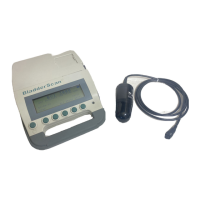85
Verathon Service Partner Manual: Reference Documentation
ACCURACY SPECIFICATIONS
The following accuracy specifications assume usage per instructions, compliance with operating and storage
conditions, and scanning a tissue‑equivalent phantom.
SCANNING A TISSUE‑EQUIVALENT PHANTOM
In order to ensure that the highest standards of quality are being met, the range of accuracy used by all
service technicians when scanning a tissue‑equivalent bladder phantom is ± (10% + 10 mL). For example, if a
tissue‑equivalent phantom is 132 mL, an accurate test result would be within 109 and 155 mL, as follows:
FORMULA EXAMPLE
± (10% + 10 mL)
10% (13 mL) + 10 mL = 23 mL
132 – 23 mL = 109 mL
132 + 23 mL = 155 mL
Record the accuracy range of your tissue‑equivalent phantom(s) below. Accuracy is compromised if the user
does not obtain an optimal, repeatable image within the accuracy range.
Our tissue‑equivalent bladder phantom is _______ mL, and the range is _______ to _______ mL.
SCANNING A PATIENT
Given the tremendous variation of healthy and compromised human anatomy, a guaranteed accuracy
specification for the instrument used on humans would be difficult. The accuracy that an individual achieves
when using the BVI3000 depends on properly aiming the probe so that the bladder falls entirely within the
measurement cone. Ensure that you follow the instructions for use in the Operations & Maintenance Manual.
The following accuracy range calculations are used when scanning human anatomy with a BVI3000 instrument.
Table 3. Scanning Accuracy Range
BLADDER VOLUME ACCURACY RANGE
0 to 699 mL ± (20% + 20 mL)
700 to 999 mL ± (25% + 25 mL)

